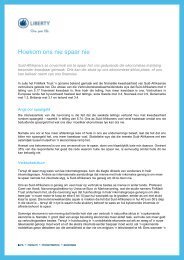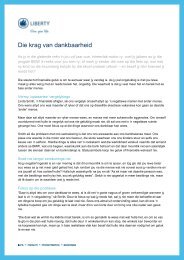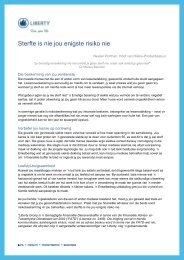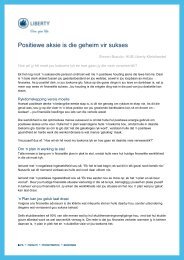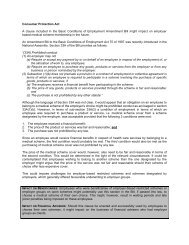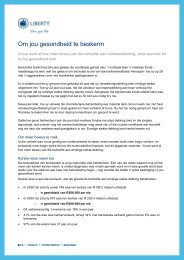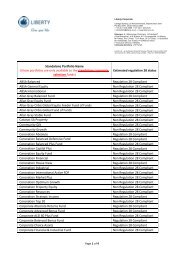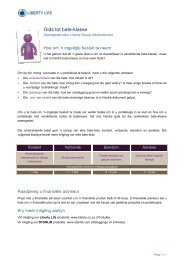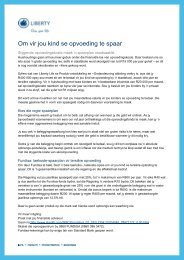Your retirement money pot
Your retirement money pot
Your retirement money pot
You also want an ePaper? Increase the reach of your titles
YUMPU automatically turns print PDFs into web optimized ePapers that Google loves.
<strong>Your</strong> <strong>retirement</strong> <strong>money</strong> <strong>pot</strong><br />
You can manage your <strong>retirement</strong> plan more effectively by separating your <strong>retirement</strong> savings from<br />
your short- and medium-term savings (like your child’s education or a deposit for a home). You<br />
can use a <strong>retirement</strong> savings vehicle, such as your company pension/provident fund or a<br />
<strong>retirement</strong> annuity (RA), to put your <strong>retirement</strong> <strong>money</strong> in a separate ‘<strong>money</strong> <strong>pot</strong>’.<br />
A <strong>retirement</strong> savings vehicle is a savings plan that helps to create a disciplined approach to<br />
<strong>retirement</strong> savings and also gives you tax benefits and protection from creditors. We look at how<br />
some of these <strong>retirement</strong> vehicles work, and what their benefits are.<br />
Protection from temptation<br />
Retirement savings vehicles help keep your <strong>retirement</strong> <strong>money</strong> safe. Because you have limited<br />
access to your <strong>money</strong>, you can’t be tempted to use your <strong>retirement</strong> savings for short-term<br />
spending – but make sure that you also have emergency savings for those unexpected events.<br />
Protection from creditors<br />
Creditors (people you owe <strong>money</strong> to) can’t claim funds held in any pension fund, provident fund or<br />
<strong>retirement</strong> annuity policy. When you buy an annuity on <strong>retirement</strong>, creditors also cannot claim the<br />
capital value.<br />
However, legal changes allow payments to be made from a <strong>retirement</strong> fund, for example to an exspouse<br />
in the case of a divorce.<br />
Tax benefits<br />
You can invest up to 15% of your income into a <strong>retirement</strong> vehicle without having to pay capital<br />
gains tax or interest income tax on this investment. This tax saving has a significant impact on<br />
your final <strong>retirement</strong> nest egg.<br />
When you retire, you will not pay capital gains tax or interest income tax on <strong>money</strong> transferred to a<br />
post-<strong>retirement</strong> vehicle such as a living annuity. Only the monthly withdrawals are taxable as<br />
income.<br />
Since 1 January 2009 there is no estate duty on approved <strong>retirement</strong> fund benefits, but if the<br />
benefit pays out as a lump sum, income tax will be applied.
Where to invest Company fund or RA<br />
A sound financial strategy is to save 15% of any income over and above your pensionable salary<br />
into a <strong>retirement</strong> vehicle as this saving is tax-free.<br />
If your company allows you to invest 15% of your bonus into your existing provident or pension<br />
fund, this can be a cost-effective way of increasing your <strong>retirement</strong> savings as the costs of a large<br />
pension fund can be lower than that of an RA. However, this is difficult to administer and not all<br />
companies offer this option.<br />
You can then consider an RA which lets you invest a monthly amount, or pay in a lump sum at the<br />
end of the year to take advantage of your tax-free allowance. <strong>Your</strong> financial adviser would be able<br />
to calculate this amount for you.<br />
The benefit of an RA over a company pension fund is that your RA is not affected when you<br />
change employers. It also gives more investment flexibility as company pension funds usually limit<br />
your investment choices.<br />
5 tips for <strong>retirement</strong> planning<br />
1 | Choose 55 as your <strong>retirement</strong> age. You can always extend the age and it provides you with<br />
more flexibility around structuring your <strong>retirement</strong>.<br />
2 | Invest 15% of your bonus into a <strong>retirement</strong> vehicle to maximise the tax advantage.<br />
3 | You don’t have to convert to an annuity immediately on <strong>retirement</strong>. You can keep your <strong>money</strong><br />
invested in a <strong>retirement</strong> product benefiting from tax-free growth until you need to draw an<br />
income.<br />
4 | When retiring, first use your savings you invested outside of your <strong>retirement</strong> vehicle. The<br />
income from these investments is generally not taxable if you did not receive a tax benefit<br />
when saving in those vehicles.<br />
5 | Once you’ve retired, keep saving a portion of your income so that you build up a safety net for<br />
emergencies.



